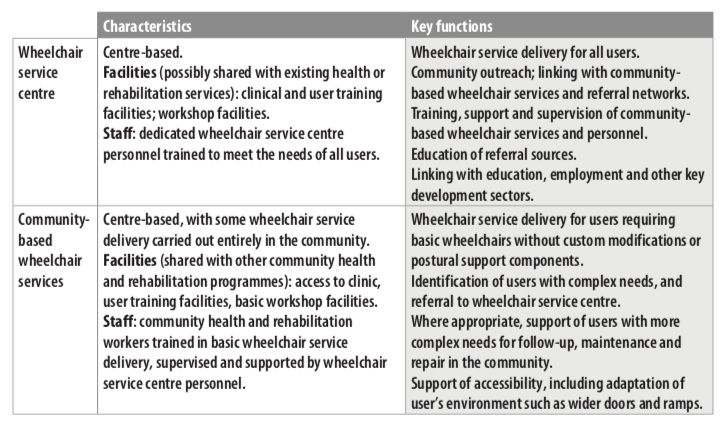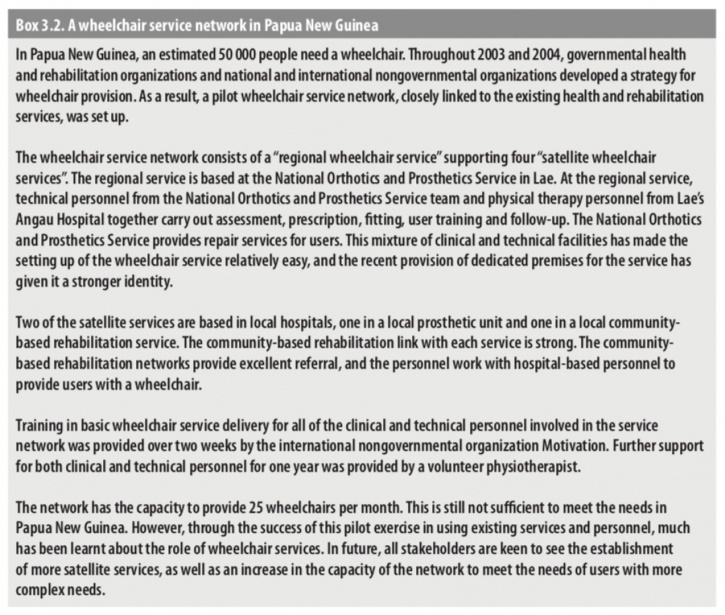Wheelchair Services
Original Editor - Naomi O'Reilly as part of the Wheelchair Service Provision Content Development Project
Top Contributors - Naomi O'Reilly, Kim Jackson, Simisola Ajeyalemi, Robin Tacchetti, Rachael Lowe, Rucha Gadgil, Amrita Patro, Jess Bell and Olajumoke Ogunleye
Introduction[edit | edit source]
The right to personal mobility is an important first step to remain healthy, independent and productive. People with difficulty in walking or moving around often require access to an appropriate wheelchair, according to their need and choice for their mobility. Independent mobility and having access to a wheelchair and other seating assistive technology are considered a basic human right,[1][2] but only a well-functioning wheelchair provision system with well-trained personnel can guarantee the highest possible personal mobility. [3] Barriers to wheelchair provision (such as wait times and funding constraints) impact on patients' rights and personal freedom. These barriers can occur throughout the provision timeline, from initial assessment to wheelchair maintenance.[4]
The provision of an appropriate wheelchair that meets the user’s physical, functional and environmental needs as much as possible requires an approach that responds to individual needs. An effective way of meeting the individual needs of users is to promote the provision of wheelchairs through wheelchair services. Wheelchair services work with wheelchair users to find the most suitable wheelchair among those available to meet the needs for that user. Careful planning and management of services and well-thought-out strategies for wheelchair provision, user instruction and care are needed to facilitate the important link between the user and the wheelchair.
Appropriate provision of wheelchairs is most important in the successful rehabilitation of people who need a wheelchair for mobility. Historically, however, wheelchair service delivery has not been an integral part of rehabilitation services. This is due to many factors, including poor awareness, scarce resources, a lack of appropriate products, and a lack of training for health and rehabilitation personnel in wheelchair service delivery.
In many countries, users depend on charity or external donations. Donated wheelchairs are often inappropriate and of poor quality, giving further problems for the user and for the country in the long run. Users are not in a position to demand good quality from charities. A study in India revealed that 60% of wheelchair users who had received donated wheelchairs stopped using them owing to discomfort and the unsuitability of the wheelchair design for the environment in which it was used.
The result is that many people who require a wheelchair do not receive one at all, while those who do often get one without any assessment, prescription, fitting and follow-up. Many users, even people with spinal cord injury, often get wheelchairs without a cushion or basic instructions, which can lead to pressure sores and even premature death.
There is, however, increasing awareness of the importance of providing individual assessment, fitting and training in how to use a wheelchair. In a number of less-resourced settings, wheelchair services have been established using different models of service delivery. Such models include centre-based or community-based services, outreach services, mobile “camp”-style services and donations of imported wheelchairs. In countries where user groups are well informed and service providers have the necessary knowledge and support, wheelchair services are becoming integrated into existing rehabilitation activities. The common aim is to ensure that users are given skilled assistance in selecting the most appropriate wheelchair for their needs.
Wheelchair provision is about enabling people with disabilities to become mobile, remain healthy, and participate fully in community life. Wheelchair services provide the framework for assessing individual user needs, assist in selecting an appropriate wheelchair, train users and caregivers, and provide ongoing support and referral to other services where appropriate.[5] A range of different models for service delivery exist and countries need to develop a model which is suitable for their given context and capable of responding to the identified needs within the country. Integration and decentralization of service delivery are important considerations and can help improve the availability, accessibility and affordability of services. Similarily providing community-delivered services as a part of the continuum of care e.g.Community-Based Rehabilitation (CBR), can respond to issues such as hard-to-reach populations (i.e. people living in rural and remote areas) and workforce shortages. The role of CBR personnel might be to work with people with disabilities and their families to determine their needs for mobility devices, initiate referrals to appropriate service provid- ers, facilitate access to services, and ensure maintenance, repair and replacement when necessary.
Strategies[edit | edit source]
Wheelchair service delivery requires careful planning and management of resources. It also requires adequate education and training of everyone involved in wheelchair provision.[6] A number of strategies that can be employed to initiate or further develop wheelchair services are discussed below. [5]
Providing Wheelchairs Together with Services[edit | edit source]
There are different methods of wheelchair supply to meet the range of contexts in which users live. Whatever the method or structure chosen, it is important to deliver essential wheelchair services.
Utilising Existing Personnel[edit | edit source]
It is not necessary to create a new profession to provide wheelchair services. With additional training, many health and rehabilitation personnel would be able to take on the duties required for basic wheelchair service delivery. For example, community health care workers, community-based rehabilitation workers, nurses, physiotherapists, occupational therapists, orthotists and prosthetists could be trained to fulfil the clinical role in wheelchair services. Likewise, with additional training, skilled craftspeople, mechanics and orthotic and prosthetic technicians could fulfil the technical role.
Meeting the Needs of Users at Community Level[edit | edit source]
Some aspects of wheelchair provision can be carried out in the community, through a network of community-based organizations (for example rehabilitation and health programmes) supported by a local wheelchair service centre. The personnel of the community-based programmes could be trained by wheelchair service personnel in basic service delivery. This system of service delivery would best suit users who require a basic wheelchair, without modifications, postural support or pressure management care.
Users with more complex needs are likely to require the skills of personnel with greater training than can be provided to all community-level personnel. This need can be addressed by outreach services coordinated by the wheelchair service centre. If outreach services are not developed, these users would need to travel to the wheelchair service centre. However, once provided with an appropriate wheelchair, they may be supported by community-based personnel.
A wheelchair service can make use of the skills, technologies and capacities of local industries. For example, bicycle repair shops can also repair wheelchairs, and tubular furniture makers have the basic skills and knowledge to build wheelchairs.
Fig.1 provides a summary of a “two-tier” wheelchair service approach. This shows a possible model linking a wheelchair service centre with a number of community-based wheelchair services. To provide adequate support to the community-based centres, it may be necessary to first develop the wheelchair service centre. Alternatively, a collaborative effort between existing community- based centres could work towards the development of the wheelchair service centre. In either case, the development process should be based on a needs assessment and other aspects of the local context.Integrating Wheelchair Services into Existing Rehabilitation Services[edit | edit source]
A wheelchair service centre or department can be established within existing rehabilitation services. Such services are already likely to have users accessing the service for health or rehabilitation needs. They would therefore already have much of the infrastructure required. Examples of rehabilitation services well suited to the integration of a wheelchair service include prosthetics and orthotics services and spinal injury centres.
Wheelchair services could play a dual role, providing wheelchairs directly to users and supporting basic services in the community through partnerships with community-level programmes and organizations.
Stakeholders and Resources[edit | edit source]
Stakeholders directly involved in the planning, implementation and participation in service delivery include:
- users and their families or caregivers;
- government authorities, including ministries responsible for health, social welfare and education and other relevant departments and local authorities;
- existing health and rehabilitation services (including referral networks) managed by governmental, private, nongovernmental, international nongovernmental or disabled people’s organizations;
- supporting organizations providing technical input or funding;
- rehabilitation personnel and their organizations; and
- wheelchair service personnel.
The resources required to implement the recommendations include:
- a reliable supply of wheelchairs that meet agreed standards;
- access to different types and sizes of wheelchair to meet the varied needs of individual users;
- personnel with training in wheelchair service delivery;
- facilities (which may be shared with existing rehabilitation or health services): • clinical facilities providing sufficient space for assessment, basic user training and storage ofwheelchairs, and • workshop facilities, particularly where modifications to wheelchairs are offered or posturalsupport is provided;
- materials for wheelchair modifications and custom components; and
- funding to support wheelchair service delivery (products and services).
Case Study[edit | edit source]
Resources[edit | edit source]
Wheelchair Services Policy & Action Plans[edit | edit source]
- Humanity & Inclusion Policy Paper - The Provision of Wheeled Mobility and Positioning Devices
- NHS Scotland Wheelchair and Seating Services Modernisation Action Plan
- Portsmouth Hospitals Patient Rehabilitation Wheelchairs Policy
- Kwa-Zulu Natal Department of Health Wheelchair / Buggy and Wheelchair Cushion Policy
- Provision of wheelchairs in Tajikistan: economic assessment of alternative options
Example of Various Wheelchair Services[edit | edit source]
Europe
North America
Australasia
Relevant Evidence[edit | edit source]
Wheelchair Services Innovations[edit | edit source]
References[edit | edit source]
- ↑ Gowran RJ, Clifford A, Gallagher A, McKee J, O'Regan B, McKay EA. Wheelchair and seating assistive technology provision: a gateway to freedom. Disabil Rehabil. 2020 Jun 8:1-12.
- ↑ Kamaraj DC, Bray N, Rispin K, Kankipati P, Pearlman J, Borg J. A conceptual framework to assess effectiveness in wheelchair provision. Afr J Disabil. 2017;6:355.
- ↑ Sarah Frost, Kylie Mines, Jamie Noon, Elsje Scheffler, and Rebecca Jackson Stoeckle. Wheelchair Service Training Package for Managers - Trainers Manual. World Health Organization, Geneva. 2015
- ↑ Gallagher A, Cleary G, Clifford A, McKee J, O'Farrell K, Gowran RJ. "Unknown world of wheelchairs" A mixed methods study exploring experiences of wheelchair and seating assistive technology provision for people with spinal cord injury in an Irish context. Disabil Rehabil. 2020:1-13. Epub ahead of print. PMID: 32970492.
- ↑ 5.0 5.1 William Armstrong, Johan Borg, Marc Krizack, Alida Lindsley, Kylie Mines, Jon Pearlman, Kim Reisinger, Sarah Sheldon. Guidelines on the Provision of Manual Wheelchairs in Less Resourced Settings. World Health Organization; Geneva: 2008.
- ↑ McSweeney E, Gowran RJ. Wheelchair service provision education and training in low and lower middle income countries: a scoping review. Disabil Rehabil Assist Technol. 2019;14(1):33-45.
- ↑ North West Commissioning Support Unit. Innovation in Wheelchair Services: Leeds Wheelchair Services. Available from: https://youtu.be/0erNhVByaNo
- ↑ North West Commissioning Support Unit. Innovation in Wheelchair Services - Liverpool Wheelchair Service. Available from: https://youtu.be/OC5I2EwCiwM[last accessed 30/06/18]
- ↑ North West Commissioning Support Unit. Innovation in Wheelchair Services - Preston SMRC. Available from: https://youtu.be/OkZlhcErAcc[last accessed 30/06/18]
- ↑ North West Commissioning Support Unit . Innovation in Wheelchair Services - Shropshire Wheelchair and Posture Service. Available from: https://youtu.be/EzIum5svfmc[last accessed 30/06/18]








